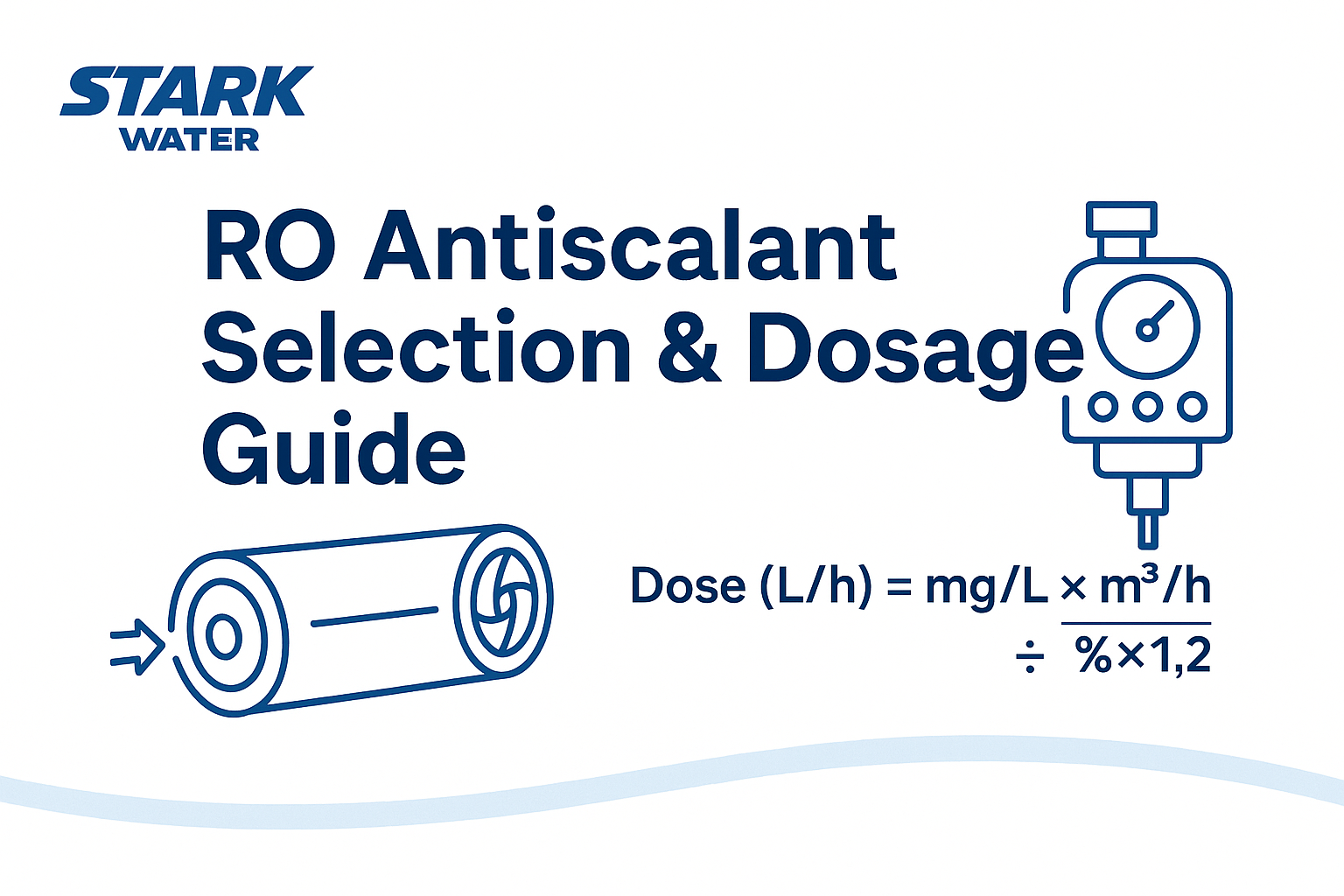RO antiscalant is the fastest, most economical way to push recovery without inviting scale on your reverse osmosis membranes. This engineering-first guide shows when to use it, how to choose the right chemistry, and how to calculate a safe ro antiscalant dosage for stable flux and ΔP.
1) How RO scaling happens
Scaling occurs when sparingly soluble salts in the concentrate exceed their solubility and begin to nucleate on the membrane surface. Symptoms include gradual flux loss, rising differential pressure (ΔP), declining salt rejection, and more frequent CIP. The usual suspects are: CaCO₃ (alkalinity/pH driven), CaSO₄, BaSO₄, SrSO₄ (recovery and temperature dependent), and silica (pH/temperature chemistry).
Background reading: Reverse osmosis fundamentals.
2) When you actually need RO antiscalant
Use antiscalant when your target recuperación y feed chemistry push indices beyond safe limits even after reasonable pretreatment. A quick checklist:
- Indices trend risky at design pH: LSI/S&DSI positive, sulfate saturation high, silica near supplier limit.
- Quality gates: SDI ≤ 5 before RO; free chlorine 0 mg/L; Fe/Mn kept low upstream.
- Alternatives considered: softening (for hardness), acid/pH trim, silica control, staged recovery, or blending.
- Economics: if brackish recovery ≥ 70%, ro antiscalant plus staged recovery is commonly lower CAPEX/OPEX than oversizing pretreatment.
3) RO antiscalant selection (salt-limit matrix)
Match the product to the limiting salt. When vendor software isn’t available, start with this matrix and confirm with your supplier.
| Limiting salt | Typical approach | Notas |
|---|---|---|
| CaCO₃ | Polymer/organophosphonate blend | Combine with pH control; monitor alkalinity trend |
| CaSO₄ | Sulfate-focused inhibitor | Check temperature & recovery sensitivity |
| Ba/SrSO₄ | High-performance inhibitor | Very low solubility—keep safety margin |
| Silica | Silica-specific inhibitor | Observe supplier’s ppm limit vs. pH & temperature |
Compatibility checklist before ordering:
- Membrane type (RO/NF) and chemistry (polyamide); supplier compatibility letter if in doubt
- Wetted materials along the dosing path (PTFE/EPDM/FKM, PVC/SS316L)
- Storage temperature, shelf life, and hazard classification for your site
4) RO antiscalant dosage formula (with example)
For brackish water, field programs often start at 2–5 mg/L then refine via vendor curves and operating data. To size the dosing pump quickly:
Required chemical flow (L/h) = Target dose (mg/L) × Water flow (m³/h) ÷ Solution concentration (%) × 1.2 (safety)
Example: Dose 3 mg/L at 20 m³/h using a 10% solution → 3 × 20 ÷ 10 × 1.2 = 7.2 L/h. Select a pump rated ≥ 10 L/h at your design backpressure for headroom.
Related hardware: Choose a reliable metering pump and provide turbulent mixing (static mixer or straight length after injection). See our Bombas dosificadoras y accesorios, Cartridge/Bag Filtersy Membrane Housings (SS/FRP).
5) Injection point & mixing best practices
- Position: Inject into the RO feed header after pretreatment and dechlorination, but before high-pressure pump.
- Hydraulics: Provide turbulence or a static mixer; avoid dead legs. Keep 10–20× pipe diameters for mixing if no mixer.
- Backpressure: Fit a back-pressure valve on the discharge of the dosing pump to prevent siphoning and stabilize stroke.
- Materiales: Use chemical-compatible tubing/valves; label lines and include an isolation flush.
- Interlocks: Tie pump enable to RO run status; alarm on low tank level and low flow.

6) Monitoring KPIs & CIP handover
Antiscalant is working when your operating trends remain stable. Track:
- ΔP across stages (creep ≤ design allowance); investigate step changes
- Permeate conductivity/salt rejection (verify probes and temperature compensation)
- CIP frequency and effectiveness (clean/dirty baseline comparison)
- SDI/turbidity upstream and across prefilters
Shift to CIP when ΔP or flux loss exceeds limits. Use acid/alkaline sequences per membrane supplier and your foulant analysis.
7) Pros & cons vs alternatives
7) Pros & cons vs alternatives
| Option | Pros | Cons | Best for |
|---|---|---|---|
| RO antiscalant | Low CAPEX, quick to implement, adjustable | Ongoing chemical cost; needs monitoring | High recovery brackish water; seasonal variability |
| Softening (ion exchange) | Removes hardness at the source | Salt & wastewater; footprint | Very hard feeds causing carbonate scale |
| pH control / acid dosing | Simple, effective for CaCO₃ | Corrosion risk; handling acids | Carbonate-dominated scaling |
| Staged recovery / blending | Lower concentration per stage | More equipment and controls | High TDS or mixed-salt constraints |
8) Download & engineering support
Need a one-pager to size your ro antiscalant pump and plumbing? Contact our team for a dosage calculator sheet and a piping sketch tailored to your plant. Send your water analysis and recovery target via the left CTA—our engineers reply within 24 hours with sizing and an alternate plan.
Preguntas frecuentes
Can I mix different antiscalant brands?
It’s not recommended. Products are validated differently and may not be compatible. If switching, flush the line and confirm membrane compatibility first.
What if silica is my limiting factor?
Choose a silica-focused inhibitor and watch pH and temperature; suppliers specify allowable silica concentration vs pH. Consider staged recovery or partial softening if still constrained.
How do I verify the dose is working?
Trend differential pressure, permeate quality, and CIP intervals. After commissioning, document a clean baseline so you can spot drift early. Quarterly reviews are useful.
Is antiscalant food-grade?
Certain formulations are available with food-contact documentation. Request the compliance documents and material certificates required by your process.

